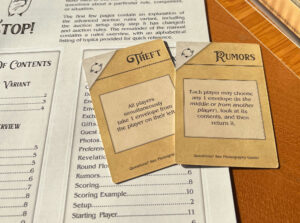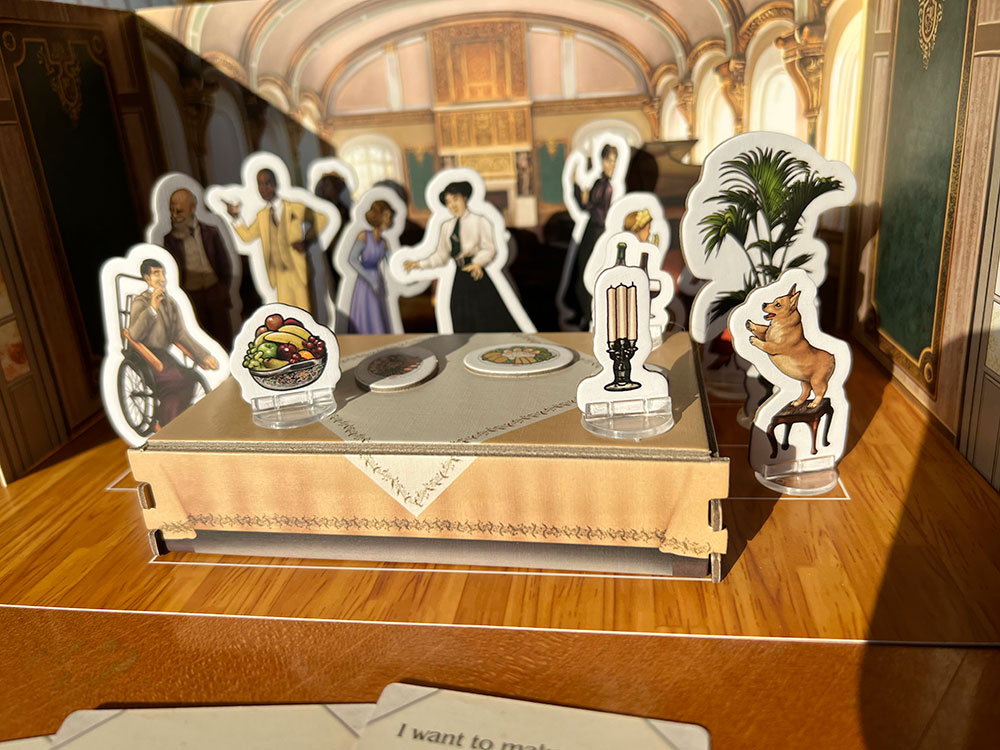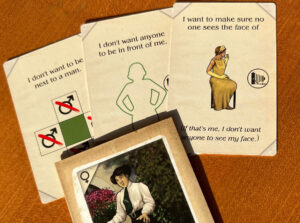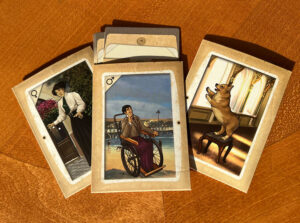 Party guests dressed to the nines circulate around the dinner table. Meaningful glances are traded, rowdy children are scolded, and a spunky corgi winds its way through guest’s feet threatening to upend the decorative plant in the corner. As the photographer for the evening, you puzzle through each of the guest’s requests to plan the group photo at the end of the night. Some only want to be seen near certain people, others only like the lighting in specific spots in the room. Can you please them all before the camera clicks and everyone says “Cheese”?
Party guests dressed to the nines circulate around the dinner table. Meaningful glances are traded, rowdy children are scolded, and a spunky corgi winds its way through guest’s feet threatening to upend the decorative plant in the corner. As the photographer for the evening, you puzzle through each of the guest’s requests to plan the group photo at the end of the night. Some only want to be seen near certain people, others only like the lighting in specific spots in the room. Can you please them all before the camera clicks and everyone says “Cheese”?
Picture Perfect is a puzzle and deduction game for 2-4 players.
Gameplay Overview:
Each player of Picture Perfect is set up with their own 3D party room diorama, with a cardboard table, decorations, and standees representing the 14 party guests. Around the table a grid is marked on the floor, showing the spaces that the standee characters can occupy. For each character, there is an envelope loaded with 3 cards, the cards showing the character’s secret posing preferences. Maybe they can only be on a certain side of the room, or near a certain character. Some will specify that their face must be blocked, or that they can’t be seen near characters of the opposite gender.

These secret preferences are revealed slowly throughout the game, through a series of action cards that guide how the players pass the character packets around. Will you get to see new information, or be bounced back the same packets that you just tried to pass on?
After a set number of rounds, each player takes out their own camera and captures a perfect shot of their finished diorama for scoring. The final score is awarded based on how many requests each player was able to successfully fulfill, and the winner gets the satisfaction of knowing they are high society’s favorite photographer.

Game Experience:
Picture Perfect is a delightfully thematic game that captures the salacious, gossipy nature of dinner party scenes from historical dramas like Downton Abby. You have to wonder about the secret conflicts and petty reasoning that have created so many placement challenges for your photographer. The characters are diverse, and their preferences give them each unique personality.

You may come to hold a grudge against the woman in yellow who refuses to be seated on the left side of the room, doesn’t want to be near the corgi, and demands that her face be hidden in the final photo. Who wouldn’t want to stand next to the corgi? In the next game you play, as her preference cards are shuffled around, she may be a dream to accommodate. This randomization gives the game a good degree of replay value. There are several expansions that add new characters and preferences to bring even more variety into the game. The details in the components really tie the mechanics into the theme, bringing each character you place to life.
The art in each of the four-player room dioramas varies slightly from one another, with two featuring indoor parties and two featuring outdoor party scenes. The designs on these are painterly and lovely, and the standee character art is full of expression and detail. The only drawback to these components is that the standees are cardboard, and there isn’t enough room in the box to leave them assembled. Taking the plastic base on and off is cumbersome and can damage the art if you’re not careful. There is an acrylic upgrade available to solve this problem, if you’re inclined to spend the money to improve your base set. It doesn’t impact your ability to play the game or appreciate the challenges gameplay presents.

The complexity of Picture Perfect’s challenge comes from strategizing how to best arrange your characters based on the limited information you’re able to glean. You don’t lose points for characters that you do not place, so it’s up to you to push your luck and decide if you’ve learned enough about their preferences to make a guess. As your fellow players try to puzzle through the same requirements, realizing as a group how differently you played despite having roughly the same information available is an entertaining reveal. It’s fun to compare your final photos and see what everyone did differently.
This isn’t a game that relies heavily on player interaction. It feels more like a roll and write in its style of parallel play. While you are passing packets of cards back and forth between players, your diorama is hidden from your neighbors until that final photo. It’s easy to get zeroed in on your own scene as the puzzle lightly sizzles your brain. Players who thrive on aggressive ‘take that’ play styles will likely be disinterested in what this game has to offer, but ones who like a light and thematic brain burner with unique art will find plenty to appreciate.
Final Thoughts:
Picture Perfect is a solid game for players looking to scratch a puzzle itch. It’s approachable and quick to learn, with a great theme that is told through the art. There are some component issues, and it may be too gentle for competitive players, but it’s perfect for gamers looking to stir up some gossipy drama and appreciate some lovely art.
Final Score: 3 Stars – Picture Perfect is a nice, light puzzle, but needs additional upgrades to be enjoyed long-term.
 Hits:
Hits:
• Beautiful art with lots of personality
• Deceptively challenging puzzle
• Unique theme and gameplay
Misses:
• Components are likely to be damaged with repeated play
• Not a lot of player interaction





















